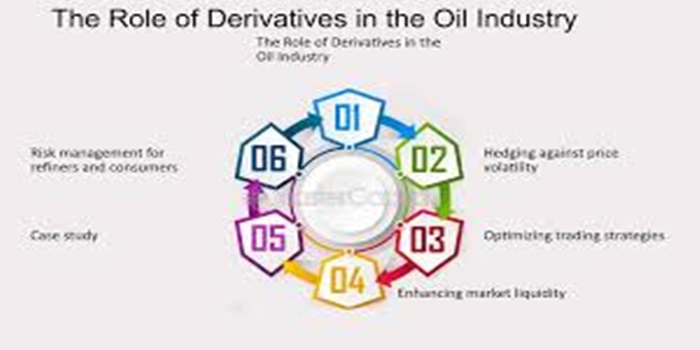In this article, we discussed derivatives in oil and gas, the types, the strategies, the benefits, we also talked about the roles.
Definition
Derivatives are financial contracts, set between two or more parties, that derive their value from an underlying asset, a group of assets, or a benchmark. A derivative can trade on an exchange or over the counter. Prices for derivatives derive from fluctuations in the prices of underlying assets.
Types of Derivatives Used in Oil Risk Management
Futures Contracts
Definition: A standardized agreement to buy/sell a specific amount of oil at a predetermined price on a future date.
Market: Traded on exchanges (e.g., NYMEX WTI futures).
Hedging Use:
Oil producers lock in selling prices to secure revenue.
Refiners or transporters hedge input costs.
Options Contracts
Definition: Gives the holder the right, but not the obligation, to buy or sell oil at a predetermined price within a specific time.
Call Option: Right to buy.
Put Option: Right to sell.
Hedging Use:
Allows companies to hedge with downside protection while retaining upside potential.
Premium is paid upfront for this flexibility.
Swaps
Definition: A bilateral agreement to exchange cash flows related to oil prices.
Common Form: Fixed-for-floating swap, where one party pays a fixed price and receives the market price (or vice versa).
Hedging Use:
Used by both producers and consumers to stabilize revenue or costs over time.
Popular in long-term contract hedging.
Forwards
Definition: Customized, non-standardized contracts to buy/sell oil at a future date.
Difference from Futures:
Traded OTC (not on exchanges).
Flexible but with higher counterparty risk.
Derivative Strategies for Risk Management
Hedging by Oil Producers
Goal: Protect against falling prices.
Typical Strategy: Sell futures contracts or buy put options.
Example: A producer expecting to sell crude in 6 months locks in today’s price via futures.
Hedging by Refiners/Consumers
Goal: Protect against rising prices of crude or refined products.
Typical Strategy: Buy futures contracts or call options.
Example: An airline company hedges against rising jet fuel prices by buying call options on heating oil futures (a jet fuel proxy).
Collar Strategy
Combines buying a put and selling a call to create a price range.
Reduces premium cost compared to pure options.
Common among companies seeking cost-effective protection.
Swap Agreements
Used for long-term price stability.
An oil producer may agree to receive a fixed price from a counterparty in exchange for paying the spot price—thus eliminating price uncertainty.
Benefits Derivatives in Oil Price Risk Management:
Financial Stability: Hedging provides a predictable and stable revenue stream or cost base, allowing companies to budget and plan more effectively. This is crucial for long-term project planning and securing financing.
Protection Against Volatility: Derivatives act as a form of insurance, protecting companies from market shocks and extreme price swings that could otherwise lead to financial distress.
Operational Certainty: By locking in prices, businesses can focus on their core operations without constantly worrying about market fluctuations.
Role of Risk Management in Oil Price Risk Management
Internal Teams: Treasury and risk management functions assess exposure and develop hedging strategies.
Advisors: Investment banks, commodity trading firms, and consultants provide pricing, structuring, and execution support.
Technology Tools: Risk analytics platforms (e.g., SAP, OpenLink, Endur) support modeling, reporting, and stress testing.
Examples of Oil Derivatives in Action
Southwest Airlines
Famously hedged jet fuel prices in the early 2000s using derivatives.
Locked in low prices and outperformed competitors during oil price spikes.
Statoil (now Equinor)
Uses options and swaps to hedge a portion of its North Sea production, reducing exposure to Brent price fluctuations.
Pemex
Mexico’s government hedges its oil revenues annually using put options.
A multi-billion-dollar program to ensure budget stability—an example of sovereign-level hedging.
Risks in Oil Price Risk Management
Basis Risk: This is the risk that the price of the derivative contract does not perfectly align with the price of the physical commodity being hedged. For example, the price of WTI crude futures may move differently than the price of the specific type of crude an oil producer sells, leading to an imperfect hedge.
Counterparty Risk: This risk is particularly relevant for over-the-counter (OTC) derivatives like swaps, where there is a risk that the other party in the agreement might default on their obligations.
Liquidity Risk: Some derivative contracts may not be actively traded, making it difficult to exit a position without affecting the price.
Opportunity Cost: Hedging limits potential losses, but it also caps potential gains. If a company has hedged its oil at a low price and the market price soars, it will miss out on the opportunity to sell at the higher rate.
Conclusion
The oil market’s volatility is an unavoidable reality, but derivatives provide a powerful toolkit for managing the associated risks. Whether through futures, options, swaps, or forward contracts, companies across the oil value chain—from upstream producers to downstream consumers—can stabilize cash flows, protect margins, and support strategic decision-making.
READ: The Concept of Oil Contract Negotiations

